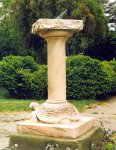|

|
Leesburg
|
Sundial: 255
|
| State/Province: Virginia |
Country: USA |
| Dial Type: Horizontal Dial |
Condition: Good |
| |
Latitude and Longitude: |
39° 2.467' N 77° 37.000' W |
| Location: |
- Oatlands Plantation, 6 miles south of Leesburg VA on US Route 15
|
| |
| Description: |
- A small bronze horizontal dial 9.25 inches (23.5 cm) in diameter on an 18 x 18 inch (46 x 46 cm) block of marble. The pedestal of Tennessee marble rests on the back of a carved tortoise. The sides of the square block capital are deeply carved with oak leaves and acorns. When the dial was seen in 1998, the dial was not aligned to north.
The dial face and gnomon are designed for 39 deg, the latitude of Oatlands. The scratched "fecit" and maker's mark of a crown implying English origin are spurious, and the date of 1717 that tries to impress observers of its early origin, is not convincing. In 2022, thanks to Joseph Murray, a second, nearly identical dial came from his father-in-law's home in Flint, Michigan or earlier in Niagara Falls, NY. This dial, shown in comparison to the Oatlands dial is stamped, showing comparative detail down to the depth and width of the 15 minute marks on the chapter ring. An easier comparison is the way the Roman numeral I for the one o'clock hour meets the dial hour line. Both of these dials were stamped with the same die. While the Oatlands dial has a slightly rusted patina, the Murray dial has the look of fresh brass never living outdoors. But the place where Murray's gnomon was ripped off shows a shiny metal underneath. They are both marked from 4am to 8pm. The Oatlands gnomon is mounted with a bracket and rivets, whose holes can be seen in the Murray sundial.
This lead to an investigation. The measurements made by Murray of the 9.25 inch dial show that it is almost exactly 1/8 inch thick and weighs 17 oz. A quick shift to metric units shows that the dial face has a density of 6.8 g/cm3. Looking for comparative metals that might have been stamped, tin with a density of 6.6 gm/cm3 fits nicely.
It is thought the Oatlands dial might have been purchased by Edith Eustis, wife of William Cocoran Eustis who owned the Oatlands estate for the first part of the 20th century. This fits nicely with the craze of tin-stamped ceilings in the late 1800's and early decade of the 1900's. We presume these two tin-stamped dials were stamped, electroplated with a thin coating of brass, and sold at a handsome profit. During the detailed examination of these two dials there was one opportunity for personalization before electroplating: If you look very closely at the word "Fecit", they are ever so slightly different on two dials, implying at least a small bit of the dial was "hand crafted".
|
| |
General Information: | Inscription: | - Owner: National Trust for Historic Preservation
| - Time passes, memories remain.
|
- Designer: fraudulent workshop
|
- Builder: stamped tin + electroplated brass
|
- Construction Date: Engraved 1717, real date circa 1900
|
| |
| References: |
- NASS Compendium Vol. 6 No. 2, p.2, June 1998
|
Last Revised: 2022-10-12 20:22

